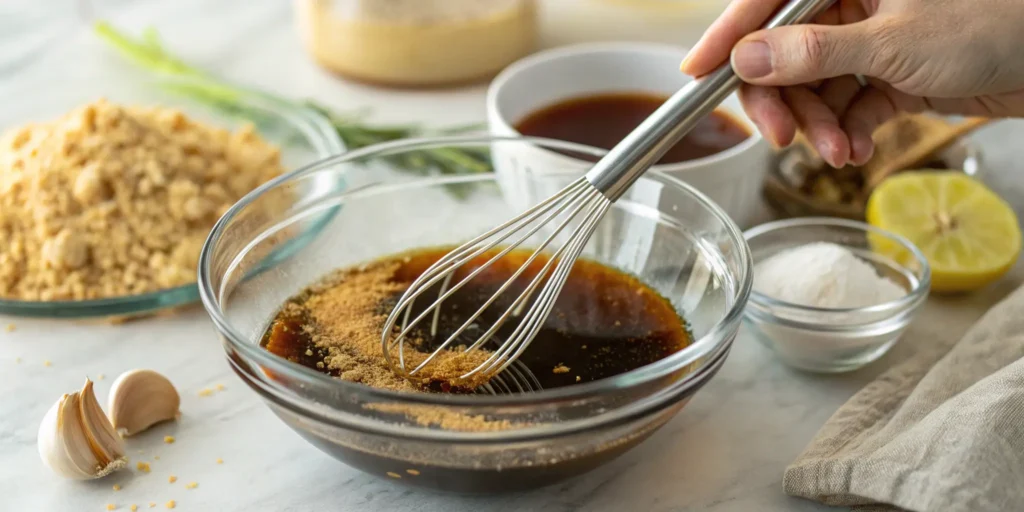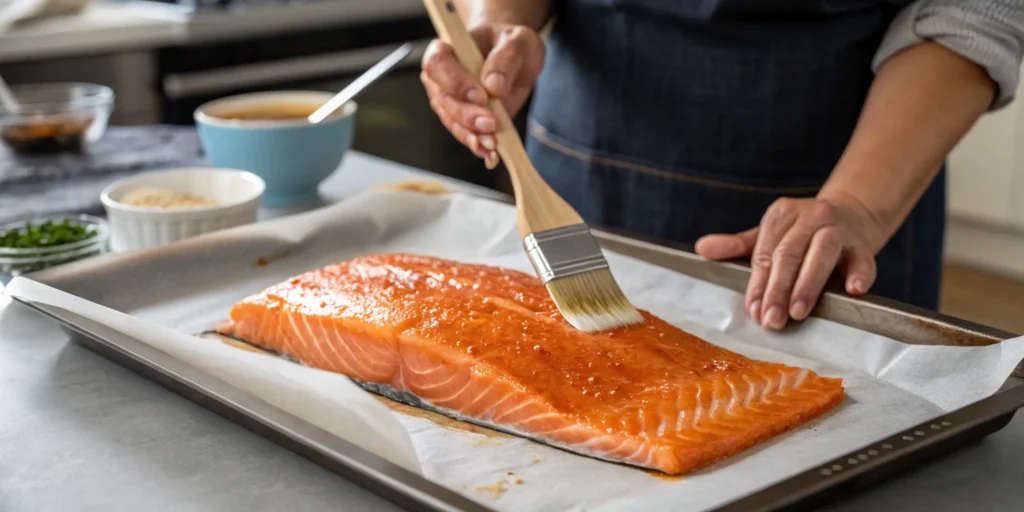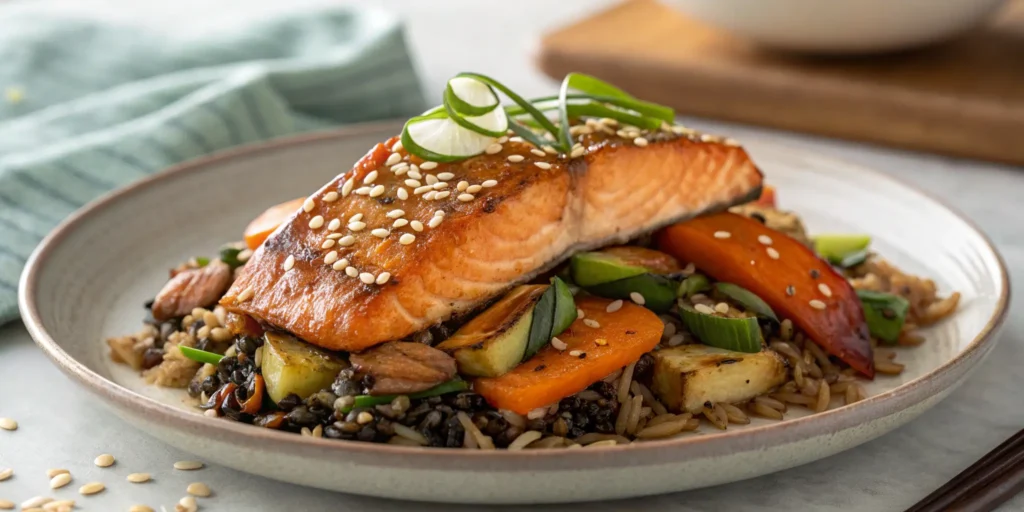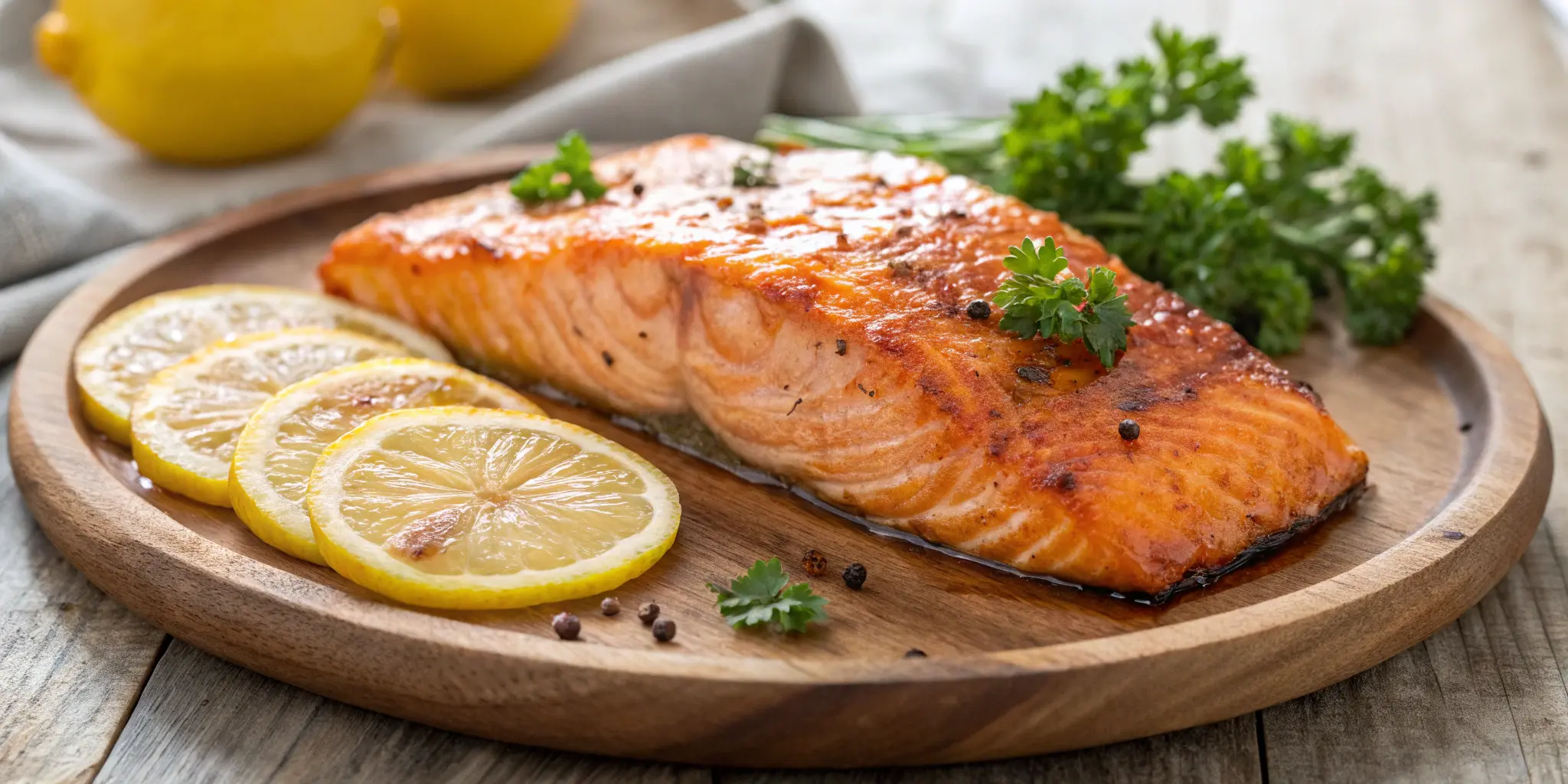Salmon Glaze Secrets: 5 Power Tips to Elevate Your Dish
Table of Contents
Discover the Magic Behind the Perfect Salmon Glaze
There’s something irresistible about the moment your fork slides through a tender salmon fillet, revealing its rich pink center, only to be coated in a glossy, flavorful glaze that sings with sweet, savory, and tangy notes. If you’ve ever cooked salmon and felt like something was missing—maybe the texture wasn’t quite right, or the flavor didn’t pop—then the answer likely lies in your salmon glaze.
Perfecting a salmon glaze isn’t just about tossing some sugar and soy sauce together. It’s about creating balance, building layers of flavor, and knowing when to apply it for the most impact. Whether you’re preparing a weeknight dinner or entertaining guests, the right glaze can turn your salmon into the star of the table.
In this guide, you’re going to uncover five transformative tips that elevate your dish from ordinary to gourmet. You’ll learn not just the how, but the why—so you can confidently craft a salmon glaze that’s tailored to your taste and technique.
Let’s dive in and unlock the secrets behind the most delicious salmon glaze you’ve ever tasted.
Understanding the Role of a Salmon Glaze
Why Glazing Matters in Salmon Recipes
When you think about what makes a piece of salmon unforgettable, your mind probably goes to texture, flavor, and presentation. A well-made salmon glaze enhances all three. But why does it matter so much? Because glazing is more than just an afterthought—it’s the final touch that brings everything together.
A good salmon glaze delivers:
- Moisture – It locks in the natural juiciness of the fish, preventing dryness.
- Flavor complexity – It blends sweetness, saltiness, and acidity to deepen the taste.
- Visual appeal – It gives your salmon a lustrous, caramelized finish that signals deliciousness even before the first bite.
You’re not just adding a glaze—you’re building layers of sensory impact. Whether you’re aiming for a sticky soy glaze or a citrusy maple drizzle, the salmon glaze becomes the bridge between the natural richness of salmon and the bold flavors you want to highlight.
There’s also a bit of science at work. As the sugars in your glaze heat up, they begin to caramelize. This chemical reaction, known as the Maillard effect, creates those mouthwatering golden-brown edges you crave. That’s where the magic happens—texture meets flavor in every bite.
Take a moment to picture the difference:
- A plain baked salmon fillet looks fine.
- A glazed salmon fillet shimmers with promise, caramelized at the edges, and dripping with flavor.
That’s the power of a proper salmon glaze—and why it deserves more than just a quick brush at the end.
Power Tip #1 – Balance Sweet and Savory Like a Pro
Mastering Flavor Harmony in Your Salmon Glaze Recipe
At the heart of every unforgettable salmon glaze is a balance—one that harmonizes sweet and savory in a way that complements the natural richness of the fish. Without that balance, your glaze can quickly swing too far in one direction, either overpowering the salmon with cloying sweetness or leaving it flat with too much salt.

So, how do you find the perfect middle ground?
You start with two core components:
- A sweet base – think maple syrup, honey, brown sugar, or even fruit preserves.
- A savory counterpart – like soy sauce, Dijon mustard, Worcestershire sauce, or miso paste.
By combining them in the right proportions, you create depth—a complexity that hits all the right notes on your tongue.
Popular Flavor Pairings for Salmon Glaze
Here’s a quick guide to combinations that always deliver:
| Sweet Element | Savory Element | Flavor Profile |
|---|---|---|
| Maple syrup | Soy sauce | Smoky, umami, slightly sweet |
| Honey | Dijon mustard | Bright, tangy, well-rounded |
| Brown sugar | Worcestershire | Deep, rich, and slightly bold |
| Orange marmalade | Tamari | Citrusy with a salty edge |
| Pineapple juice | Garlic soy glaze | Tropical and robust |
You don’t have to follow a strict formula—but a good ratio to begin with is 2 parts sweet to 1 part savory. From there, you can taste and tweak to match your preferences.
Bonus Flavor Enhancers
- Garlic and ginger: Add warmth and complexity.
- Lemon or lime zest: Offers brightness to cut through richness.
- Chili flakes or sriracha: Introduces subtle or bold heat, depending on your taste.
This kind of balance transforms your dish from “just another salmon dinner” to something your guests will rave about. A thoughtfully blended salmon glaze becomes more than a topping—it becomes the soul of the recipe.
Power Tip #2 – Use Fresh Herbs and Aromatics for Depth
Infuse Your Salmon Glaze with Layered Flavor
While sweetness and saltiness lay the foundation, the real magic of a gourmet-level salmon glaze comes from the depth of flavor—and that’s where fresh herbs and aromatics take the spotlight.
If you’ve ever tasted a glaze that felt one-dimensional, chances are it lacked these essential flavor builders. Aromatics—like garlic, shallots, or ginger—bring heat, sharpness, and warmth. Herbs—like dill, cilantro, or parsley—introduce freshness and lift the entire profile of your glaze.
You don’t need a dozen ingredients. Just a few carefully chosen additions can completely elevate your salmon glaze from flat to full-bodied.
Top Aromatics to Use in Your Salmon Glaze
- Garlic – Bold and pungent; excellent with soy or citrus bases.
- Ginger – Zesty and warm; perfect with honey or miso.
- Shallots – Milder than onions, yet rich and slightly sweet.
- Scallions – Add a clean, green flavor and mild bite.
Fresh Herbs That Complement Salmon Perfectly
- Dill – Bright, grassy, and traditionally paired with fish.
- Cilantro – Earthy and citrusy; pairs well with Asian-style glazes.
- Parsley – Clean and slightly peppery; great for finishing touches.
- Thyme – Woody and savory; best with maple or mustard glazes.
How and When to Add Aromatics to Your Glaze
- Sauté first: Blooming aromatics in oil or butter before adding sweet or acidic ingredients unlocks their flavors.
- Infuse on low heat: Simmer herbs with your glaze over low heat to steep flavor without overwhelming it.
- Strain if needed: If you prefer a smooth glaze, steep and strain the aromatics before brushing onto your salmon.
Adding herbs and aromatics isn’t just about complexity—it’s about personality. This is your chance to tailor your salmon glaze to reflect your tastes. Want something bold and savory? Go heavy on garlic and thyme. Prefer something lighter and citrusy? Use ginger and cilantro.
These small, thoughtful additions turn a basic glaze into something truly special—something that tastes as good as it smells.
Power Tip #3 – Apply the Glaze at the Right Time
Timing Your Salmon Glaze for Maximum Impact
You could have the most flavorful salmon glaze in the world, but if you apply it at the wrong moment, you risk losing everything that makes it special. Timing is a critical part of the process—it determines whether your glaze bakes into the salmon, caramelizes beautifully, or simply burns and turns bitter.
To get the best results, you need to understand when and how to apply your salmon glaze based on your cooking method.

The Art of Layering Your Glaze
One of the most effective techniques is layering. Rather than slathering the glaze on all at once, apply it in stages throughout the cooking process. This helps:
- Build up flavor gradually
- Prevent burning from excess sugar
- Create a rich, sticky surface texture
Think of it like painting. One coat gives coverage, but multiple coats build depth and finish.
Glaze Timing by Cooking Method
Here’s a breakdown of when to glaze based on how you’re cooking:
| Cooking Method | When to Apply Glaze | What You’ll Get |
|---|---|---|
| Baking | Last 5–7 minutes of cooking | Glossy, caramelized finish |
| Broiling | Just before placing under broiler | Crisp, charred top with sticky edges |
| Grilling | Midway and again in final 2 minutes | Smoky flavor with a lacquered exterior |
| Pan-searing | Last 1–2 minutes before removing | Rich glaze coating without burning |
| Air frying | After the halfway mark, lightly brushed | Crisp texture with no soggy spots |
Pro Tip:
Use a silicone pastry brush for smooth, even application. Avoid metal spoons—they tend to over-pour and can’t distribute the glaze evenly.
Timing your salmon glaze correctly gives it a chance to caramelize—not just sit there. It fuses the flavors into the fish while building that crave-worthy sheen that looks like it came straight from a restaurant kitchen.
So the next time you glaze, don’t rush it. Pause. Time it right. And give your dish the finish it deserves.
Power Tip #4 – Brighten Up with Acidity
Use Acidity to Cut Through the Richness of Salmon
Salmon is naturally rich and buttery, which is why a balanced salmon glaze needs more than just sweet and savory elements—it needs acidity to brighten the dish and keep your palate engaged.
Acid acts like a spotlight. It sharpens the other flavors, cuts through the fat, and brings a clean, fresh finish to every bite. Without it, even the best glaze can feel heavy or flat. With it, your salmon becomes vibrant, balanced, and unforgettable.
Common Acids That Work Wonders in Salmon Glaze
- Lemon juice – Classic and clean; adds freshness without overwhelming
- Rice vinegar – Mild, slightly sweet; perfect for Asian-inspired glazes
- Balsamic vinegar – Deep, complex; great with brown sugar or maple
- Lime juice – Zesty and bright; ideal for tropical or spicy glazes
- Orange juice or zest – Sweet-acidic combo; pairs well with soy and honey
You can use one or combine two acids to layer complexity into your salmon glaze. For example, orange zest and lemon juice work beautifully together for a citrus-forward finish that sparkles on the tongue.
Flavor Tip: Pair Acid with Sugar for a Balanced Glaze
Acid and sugar are natural opposites—but when combined thoughtfully, they enhance one another. For example:
- Maple syrup + rice vinegar = smooth and tangy
- Honey + lemon juice = bright and mellow
- Brown sugar + balsamic = sweet and complex
It’s not about making the glaze sour. It’s about introducing just enough acidity to balance the richness of the salmon and the sweetness of your base. The result? A dynamic glaze that keeps your taste buds intrigued from start to finish.
Think of acidity as your secret weapon. Use it sparingly but intentionally, and your salmon glaze will gain the kind of lift and dimension that takes your dish to the next level.
Power Tip #5 – Don’t Overdo It: Less is More
Mastering the Art of Restraint in Glazing
It’s tempting to drench your salmon in glaze, especially when it smells amazing and tastes even better. But the truth is, a great salmon glaze doesn’t need to overpower—it needs to complement. When it comes to glazing, restraint is the secret ingredient that keeps your salmon from turning soggy, overly sweet, or cloying.
The most successful dishes strike a careful balance between salmon’s natural richness and the glaze’s bold flavor. Too much glaze, and you mask the fish. Too little, and it barely registers. That sweet spot? Just enough to highlight, not dominate.
How Much Salmon Glaze Is Enough?
For the best balance:
- Use about 2 tablespoons of glaze per 6-ounce fillet
- Apply in thin, even layers rather than one thick coat
- Let the glaze cook onto the surface, not pool around it
This allows the salmon to caramelize gently without burning or turning mushy. If you want a more intense flavor, layer lightly more than once—just avoid applying too much too early.
Best Tools and Techniques for Glazing
- Silicone basting brush: Offers precise, even coverage
- Spoon drizzle (used carefully): Great for final touches or post-cook finishing
- Marinade bag (for pre-cook glazing): Use sparingly; don’t let the glaze sit too long, or the fish might break down
Common Glazing Mistakes to Avoid
- Applying glaze too early (especially with sugary bases)
- Reapplying too often without letting previous layers set
- Forgetting to adjust for sugar content when cooking at high heat
Sometimes, less truly is more. By allowing the natural flavor of the salmon to shine through and using your glaze as a highlight—not a mask—you create a dish that feels refined, balanced, and intentional.
The goal isn’t to drown your salmon in flavor—it’s to bring out the best of it, one brushstroke at a time.

Bonus Recipe Section – Simple Maple Soy Salmon Glaze Recipe
Elevate Your Next Dinner with This Go-To Glaze
Now that you’ve mastered the five core tips, it’s time to put your knowledge into action. This easy and reliable salmon glaze recipe hits all the right notes—sweet, salty, rich, and just the right amount of brightness. Whether you’re baking, broiling, or grilling, this glaze adapts to your method and delivers flavor every time.
Ingredients Table
| Ingredient | Quantity |
|---|---|
| Pure maple syrup | 1/4 cup |
| Low-sodium soy sauce | 2 tablespoons |
| Fresh garlic, minced | 1 teaspoon |
| Fresh ginger, grated | 1 teaspoon |
| Lemon juice | 1 tablespoon |
| Crushed red pepper flakes | 1/4 teaspoon (optional) |
Instructions
- Combine ingredients
In a small saucepan over medium-low heat, whisk together the maple syrup, soy sauce, garlic, ginger, lemon juice, and red pepper flakes. - Simmer gently
Let the mixture simmer for 5 to 7 minutes, stirring often, until it thickens slightly and becomes glossy. - Cool before using
Remove from heat and let it cool slightly. The glaze will continue to thicken as it cools. - Brush on salmon
Apply to salmon during the final 5–7 minutes of cooking (or as described in earlier tips, depending on your cooking method). For extra flavor, brush on a second layer just before serving. - Store any leftovers
Keep extra glaze in a sealed container in the fridge for up to 5 days. Reheat gently before using again.
Why This Recipe Works
- Maple syrup brings natural sweetness with subtle smoky depth.
- Soy sauce offers a salty, umami-rich backbone.
- Ginger and garlic provide warm aromatic balance.
- Lemon juice cuts through the richness of the salmon for a clean finish.
This recipe is the perfect place to start building your signature salmon glaze. Once you’ve tried it, feel free to swap out the sweetener, try different herbs, or play with spice levels. The framework is strong—but the flavor is all yours.
Conclusion – Unlock Your Salmon’s Full Flavor Potential
By now, you’ve seen just how much of a difference a thoughtfully crafted salmon glaze can make. It’s not just about taste—it’s about creating a multi-sensory experience that enhances texture, deepens flavor, and turns your salmon into a stunning centerpiece.
Let’s recap what you’ve learned:
- A perfect salmon glaze strikes a balance between sweet and savory.
- Fresh herbs and aromatics layer depth into your glaze.
- Timing is everything—when you glaze matters just as much as what’s in it.
- A touch of acidity brightens the dish and balances out the richness.
- Restraint is essential—glaze should elevate, not overwhelm.
Whether you’re preparing a weeknight meal or entertaining guests, these five power tips empower you to take control of flavor, texture, and presentation. With just a little attention to detail, your salmon can go from simple to showstopping.
The next step is yours.
Tonight, take what you’ve learned and put it into practice. Start with the maple soy glaze recipe, apply the tips you’ve picked up, and taste the difference for yourself. Your dinner table deserves more than plain salmon. It deserves a dish that tells a story—one brush of glaze at a time.
Frequently Asked Questions About Salmon Glaze
What is the best glaze for salmon?
The best salmon glaze combines sweet, savory, and acidic components to balance the richness of the fish. A classic mix like maple syrup, soy sauce, garlic, and lemon juice delivers a reliable blend of flavor. However, the best glaze is ultimately the one that suits your taste—whether it’s spicy, citrusy, or herb-forward.
Can I glaze frozen salmon?
Yes, you can, but for best results, thaw your salmon fully first. A proper salmon glaze needs to cling to a dry surface to caramelize correctly. Once thawed, pat the salmon dry, then apply the glaze during cooking as described in our timing tips.
Should I marinate or glaze salmon?
Marinating and glazing serve different purposes. Marinating happens before cooking and infuses flavor deeper into the flesh, while glazing is applied during or after cooking to create a rich, flavorful coating. For salmon, glazing tends to work better, especially when you want a bold, caramelized finish.
Can I reuse leftover salmon glaze?
If the glaze hasn’t come into contact with raw salmon, you can store it in the refrigerator for up to 5 days. Reheat gently before using. If it has touched raw fish, discard it to avoid cross-contamination. Always make a fresh batch when in doubt.
What’s a quick 3-ingredient salmon glaze?
A simple yet delicious salmon glaze can be made with:
- 2 tablespoons honey
- 2 tablespoons soy sauce
- 1 teaspoon lemon juice
Mix and brush over salmon during the last few minutes of cooking. It’s fast, flavorful, and brings balance with minimal effort.
Every question answered here is designed to support you in mastering the art of the salmon glaze. Use these tips, revisit the recipe, and most importantly—experiment. The beauty of a glaze is how it transforms with just a few tweaks, and with these insights, you’re more than ready to explore.

